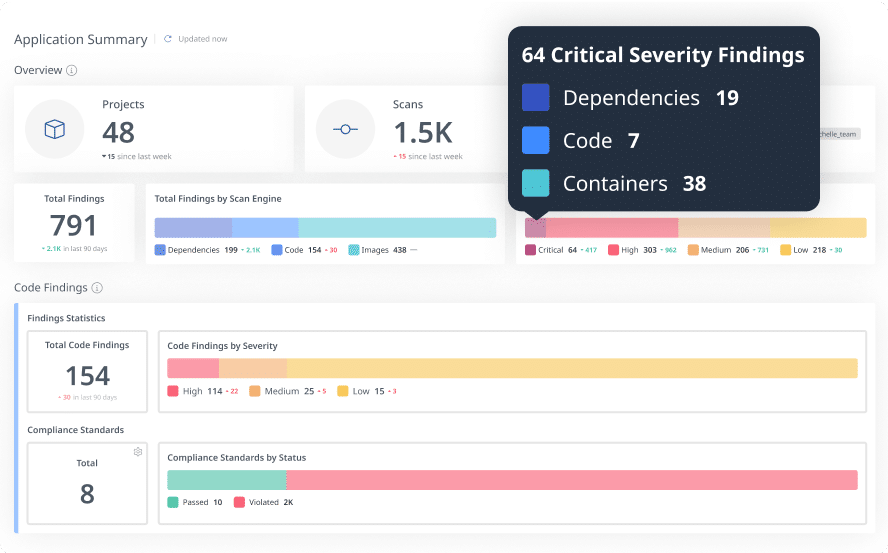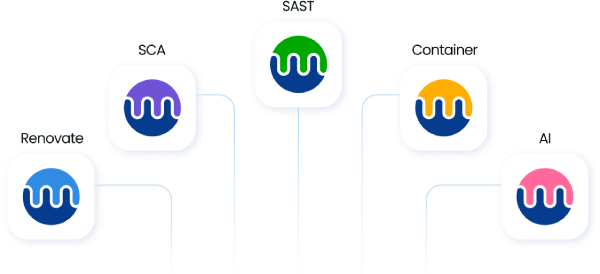Mend.io vs Snyk
AppSec Battle: Is Snyk undermining your AppSec?
Drive real impact with better governance, reachability, and limitless scalability.
Join thousands of organizations who trust Mend.io for application security




Get the accuracy, support, and scalability your AppSec team deserves
Scan without limits and gaps
Snyk users report silent scan failures, missed files, blind spots in dependencies, and inadequate container coverage. Mend.io eliminates these gaps with full-scale, continuous scanning and limitless scalability.
Don’t let license risk sink the ship
Snyk lacks file-level license detection and conflict analysis, leaving gaps in governance. Mend.io proactively detects, blocks, and provides detailed legal insights to ensure compliance.
Focus on reachable, exploitable risks
Mend.io’s risk-based prioritization ensures developers focus on exploitable vulnerabilities, not false alarms. Unlike Snyk, which flags unreachable risks and impractical fixes, Mend.io delivers precision.
Turn down dependency noise
Outdated caches, silent failures, and flawed upgrade suggestions slow teams down. Mend.io leverages insights from 1.7 billion Renovate installs to recommend the best, most secure, and stable dependency upgrades.
Operationalize AppSec program policies
Snyk’s inconsistencies and silent scan failures coupled with developers’ ability to “ignore forever”, undermine security programs. Mend.io delivers robust governance, clear visibility, and seamless adoption for proactive, scalable AppSec.
Eliminate Python and Docker blind spots
Snyk often suggests unstable updates, caches outdated versions, and overlooks critical vulnerabilities in Dockerfiles. Mend.io provides accurate detection and actionable fixes for Python and Docker risks.
Mend and Snyk comparison
|
Feature |
Mend.io |
Snyk |
|---|---|---|
|
Continuous AI Component Inventory |
Yes. |
No. |
|
Scan Efficacy |
High-performance, comprehensive scans (Mend SAST scans 10x faster with +38% better precision and +48% better recall than traditional tools) that run on commit. |
Silent failures, missed detections, CLI inconsistencies, complaints of high false positives and negatives, particularly in SAST findings |
|
AI-powered Remediation |
Clear and actionable guidance with safe (non-build breaking) AI-powered code fixes that are +46% more accurate than benchmark competitors. |
Relies on a closed AI engine to suggest code fixes. |
|
Dependency Management |
Leverages data from 1.7 billion Mend Renovate installs to recommend the optimal dependency upgrade path— the newest, most stable, least vulnerable library version that provides the most significant risk reduction. |
Flawed suggestions, outdated caches |
|
License Compliance |
File-level detection, conflict analysis |
Lacks conflict resolution, limited insights |
|
Python & Docker Security |
Accurate detection, actionable fixes |
Poor handling, outdated package suggestions |
Don’t just take our word for it: Why teams choose Mend.io
Snyk:
“The security analysis is very primitive and often flags false positive which has to be fixed with manual override or skipping the PR validation check.”
Mend.io:
“The accuracy of vulnerability detection is impressive, and we have rarely encountered false positives.”

Snyk:
“Snyk is an expensive solution.”

Mend.io:
“The pricing is reasonable and scalable, making it a good fit for our growing business.”
Snyk:
“Too much unnecessary false positives, policy overrides, hard and complex to manage and track alerts.”
Mend.io:
“The user interface is intuitive and easy to navigate, even for non-technical users.”
Snyk:
“Integrations with other systems and platforms, such as Bamboo and JFrog Artifactory, have proven challenging and need enhancement.”

Mend.io:
“The integration with our existing tools (like JIRA and Jenkins) was seamless, saving us a lot of time and effort.”
Snyk:
“Customer support is slow to respond, usually not helpful and ended up escalating to a developer, that’s when we lost all contact and did not get a solution to a clear bug that prevents us from using the product.”
Mend.io:
“The customer support team is knowledgeable and responsive, and the documentation is thorough and easy to understand.”
Snyk:
“The security analysis is very primitive and often flags false positive which has to be fixed with manual override or skipping the PR validation check.”
Mend.io:
“The accuracy of vulnerability detection is impressive, and we have rarely encountered false positives.”

Snyk:
“Snyk is an expensive solution.”

Mend.io:
“The pricing is reasonable and scalable, making it a good fit for our growing business.”
experience
Snyk:
“Too much unnecessary false positives, policy overrides, hard and complex to manage and track alerts.”
Mend.io:
“The user interface is intuitive and easy to navigate, even for non-technical users.”
Snyk:
“Integrations with other systems and platforms, such as Bamboo and JFrog Artifactory, have proven challenging and need enhancement.”

Mend.io:
“The integration with our existing tools (like JIRA and Jenkins) was seamless, saving us a lot of time and effort.”
Snyk:
“Customer support is slow to respond, usually not helpful and ended up escalating to a developer, that’s when we lost all contact and did not get a solution to a clear bug that prevents us from using the product.”
Mend.io:
“The customer support team is knowledgeable and responsive, and the documentation is thorough and easy to understand.”
Explore Mend.io’s enterprise AppSec platform
No matter your application, Mend.io has you covered


Proactive AppSec. One price.
$1,000
per developer • per year
Volume pricing available.
Frequently asked questions
How do pricing models differ between the Mend AppSec Platform and Snyk’s solutions?
Mend.io uses a fixed pricing model, offering its full platform and support for $1,000 per developer annually, making it easy to forecast costs.
Snyk’s tiered pricing can lead to unpredictable costs, especially for larger teams. Mend’s pricing model ensures all features are accessible without hidden costs, providing clear and consistent pricing for your entire security program.
What makes Mend.io’s reachability different from Snyk’s?
Mend.io’s reachability analysis focuses on identifying vulnerabilities that are actually invoked in the application’s runtime flow, using precise static code analysis to filter out unused code. This significantly reduces false positives, ensuring teams prioritize only real, exploitable risks.
In contrast, Snyk’s reachability provides a broader view by identifying potentially accessible code paths, which can increase visibility but may flag vulnerabilities that aren’t directly used. Mend’s precision helps teams save time and focus on what truly matters
What’s the difference between your dependency health and Snyk’s open source insights?
The Mend AppSec Platform leverages data from millions of repositories and 1.7 billion Mend Renovate installs to analyze package age, adoption trends, and build failure rates to pinpoint the optimal upgrade path— the newest, most stable, least vulnerable library version that provides the most significant risk reduction. With automated remediation, customers can further accelerate MTTR.
While Snyk does offer some dependency management, it struggles with accurate dependency upgrades, even suggesting ‘beta’ version upgrades that are not even possible.
What’s the difference between how the Mend AppSec Platform and Snyk handle large files for SAST scanning?
Mend SAST provides comprehensive, fast scanning with no file size restrictions. This ensures that critical vulnerabilities in large files are not missed, allowing for deeper and more reliable security insights.
Snyk has a 1MB file size limit, which impacts the comprehensiveness of your project’s security analysis. If your codebase includes critical files exceeding 1MB, they won’t be scanned. To maintain full visibility and security coverage, adjustments like refactoring are required.
Do you have any scan limits or restrictions I need to know about?
No. The platform is designed to scale with your organization’s needs.